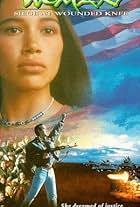Advanced search
- TITLES
- NAMES
- COLLABORATIONS
Search filters
Enter full date
to
or just enter yyyy, or yyyy-mm below
to
to
to
Exclude
Only includes titles with the selected topics
to
In minutes
to
1-10 of 10
- Marshal Matt Dillon keeps the peace in rough-and-tumble Dodge City.
- Mary Crow Dog, daughter of a desperately poor Indian family in South Dakota, is swept up in the protests of the 1960s and becomes sensitized to the injustices that society inflicts on her people. She aids the Lakota in their struggle for their rights: a struggle that culminates in an armed standoff with US government forces at the site of an 1890 massacre.
- This is a historical drama about Mato Win, an eight-year-old Native American girl who lives at Pine Ridge Indian Reservation in South Dakota. After her parents are critically injured in an accident, she is sent to live with a white family at a horse ranch in the Black Hills. She stays with Clara, an eight-year-old white girl and her family, but Mato Win is determined to get back to the reservation. She runs away to the mountainous forest but is found. Mato Win calls her brother, Tate, who is a rodeo rider to come get her. She is afraid she will be kept from her parents and does not trust Clara's older brother Cavan. Mato Win questions Clara about an old photo of two Indian men in her home. Clara tells the story of her great-great grandma, Emylon, who rode the train from Indiana to teach there, a hundred years ago. She fell in love with Frank, one of the Native American men in the photo and married him. Mato Win starts to understand why Clara says she feels the spirits too. Mato Win is confronted by a white boy at the playground. Cavan and Clara stand with her against this bully. Mato Win sees there is a difference among the white people. Tate finally arrives on his horse, and they escape into the mountains. When caught by the sheriff, Mato Win is given a choice, to go back to the reservation or to Clara's ranch. She will go back, if her brother can go too. Clara's grandma, Ilona, welcomes Tate and his horse. In the midst of racism, these children found lasting friendship.
- Where do dinosaur skeletons come from? Who are the scientists that find and study them? Who is interested in buying them and how much are they worth?
- Predators didn't dominate the Cretaceous period - plant-eaters did. And their bodies were built to take a beating. The latest science reveals the anatomical secrets that made the earth's largest vegetarians successful.
- The advantages and disadvantages of the survival strategies of the maternal instincts of the herbivore Sauroposeidon and carnivore Tyranosaurus Rex.
- More than a million generations adapted dinosaurs to a changing planet. But each successful generation boils down to a single encounter between two like-minded reptiles. The latest science reveals the anatomical secrets to life and love among dinosaurs.
- This program presents Tyrannousaurus Rex as primarily a lumbering predator and secondarily a scavenger or cannibal. Deinonycus is presented as an agile, crafty pack hunter. Quetzalcoatlus was an observant, opportunistic predator that attacked easy prey and could make a quick getaway. The sensory and killing anatomy of each animal is examined in detail as well as its diet and predatory style.







